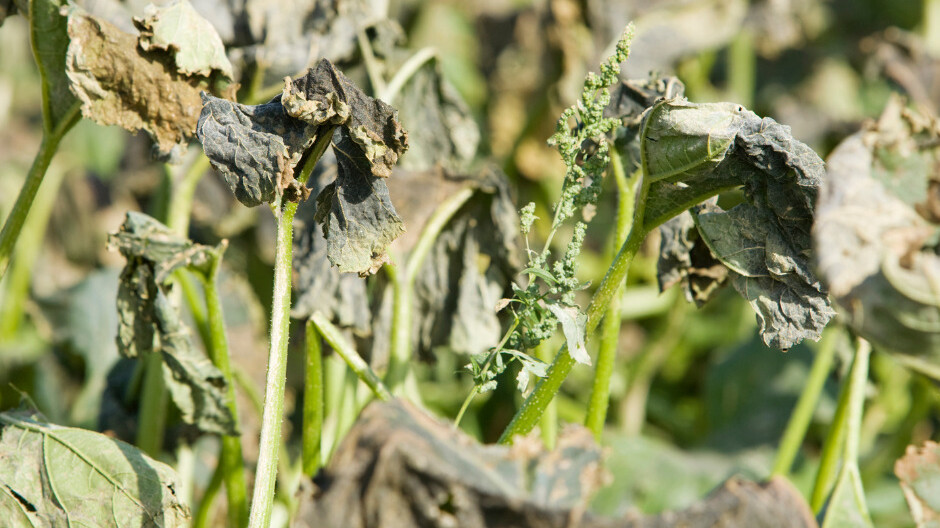So what is greywater?
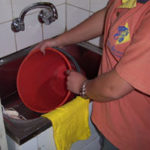 Greywater! A few years ago this was a fairly uncommon term to most of us, but nowadays we can’t go to the nursery or turn on the television without encountering greywater. But, what is it? How do we use it? What effect will it have on my garden? Is it actually grey?
Greywater! A few years ago this was a fairly uncommon term to most of us, but nowadays we can’t go to the nursery or turn on the television without encountering greywater. But, what is it? How do we use it? What effect will it have on my garden? Is it actually grey?
Greywater is technically household wastewater from the laundry (including the washing machine and tubs) and the bathroom (including showers, baths and basins). Toilet water and kitchen wastewater are regarded as blackwater and are not suitable for reuse in domestic gardens, due to the potentially high levels of bacteria, fats and solids contained in this wastewater.
The diversion of greywater from the house and into the garden has become an extremely popular way of irrigating our precious green spaces in these times of low rainfall and water restrictions. When done correctly, it is an excellent way of saving water and money. It is amazing to think that one average household (2.5 people) expels 124 100 litres of greywater a year! (from www.westernwater.vic.gov.au) That’s more water than most established gardens need in the same period. And, unlike rainwater, greywater is available all year round, regardless of the weather!
But I’ve heard greywater use is bad for plants… is that true?
Firstly, let me point out that research regarding the long-term impacts of greywater on plant and soil health is seriously lacking, so the affects of usage are, at this stage, a bit of an unknown quantity. Also, the greywater we are discussing here is untreated greywater (that is, one that has not been modified or had it’s quality improved by an approved greywater treatment system).
Remember, the quality and performance of greywater irrigation can vary dramatically, dependant on a number of factors. These include

- the type of greywater used (eg: washing machine vs. bathwater)
- the types of chemicals included in greywater (eg: soaps and washing powders)
- the irrigation method
- the type of plants being watered
- the length and duration of watering
- the soil structure and type
- the presence of soil organic matter and so on.
That said, there are some straight forward ‘do’s, don’ts’ and ‘no-you-didn’t’ regarding greywater and these have been popped together in an easy to use reference chart for you all.
Do consider a professionally installed, fail safe greywater treatment system – saves you time time, stress, effort and may make you eligible for a rebate
Do monitor your soil – check pH, smell, “life forms” eg worms, bugs etc.
Do monitor your irrigation needs – if it doesn’t need water, don’t water it!!!!!
Do disperse the water subsurface – either on top of soil and under mulch, or trenched into soil. It’s better for your plants, your health, and your back pocket (will avoid a big fat fine!).
Do allow your garden a rest from greywater – turn it off in autumn, and back on in spring!
Do think carefully about the products you use inside the house, and what affect that will have outside eg: disinfectants, hair dye, bleach, cleaners
Do restrict greywater use to your garden – untreated greywater is not suitable for washing cars, hosing down paths, washing windows etc.
Do filter out as many solids as you can.
Do get to know greywater rules and regulations – your local council, state water board and the EPA are great places to start
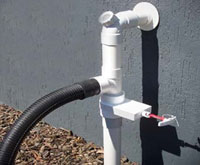
Don’t store untreated greywater for over 24hours – it’s against EPA regulations, it’s really bad for you and it stinks!
Don’t water just because the greywater is there – you’ll drown your plants and your soil, so check the soil moisture levels first and then decide
Don’t water your vegie patch with greywater – for so many reasons, this is just plain wrong!
Don’t shandy greywater with rainwater in a tank or similar – you still can’t store it, and you run a serious risk of harbouring E. coli , among other things
Don’t allow pets or people to play in pooled greywater – that’s revolting!
Don’t hose it around… it can be really contaminated – always disperse your greywater under mulch, or in the soil (subsurface)
Don’t use kitchen water or water contaminated by pee or poo… this is fairly obvious
Don’t let greywater wash into your neighbours yard or neighbouring properties – nothing says neighbourhood dispute like your waste water in the yard next door
What can I actually water with greywater?
There has been a huge increase in the use of native and indigenous plants in domestic gardens and why wouldn’t there be? They look great, are suited to local soils and conditions, create habitat for our precious native animal species and can be a lot more aridity tolerant than many exotic species. But the use of greywater on these types of gardens can be a bit of a mystery and has caused great debate among nursery folk and gardeners alike.
The four issues of most concern with regard to greywater and natives are:
· Phosphorus
· High pH
· Alkalinity
· Salinity

Talking Phosphorus
Let’s first take a look at phosphorus. Many commonly grown Australian native plants have originated in phosphorus deficient soils and high levels of phosphorus can be detrimental to the health of these plants. Phosphorus sensitivity is a particular issue with members of the Protea family (Proteaceae) which includes Banksia, Grevillea, Hakea and Isopogon. However, phosphorus sensitivity varies and it should not be assumed that all Australian native plants will not tolerate phosphorus.
With that in mind, it is always preferable to choose a detergent that contains low or no phosphorus if you are irrigating with greywater. This will avoid any detrimental affects to soil health and plant health, both in your backyard and beyond the back fence (think blue-green algal blooms). To find out whether your detergent has a high phosphorus content, check out the Lanfax Labs website www.lanfaxlabs.com.au, for detailed information on many different brands of washing detergents.
Low phosphorus detergents must be used in any long-term application of grey water from laundry sources, regardless of the phosphorous sensitivities of plants or not. Excessive phosphorus is unable to be taken up by plants, and has the potential to damage soil structure, as well as leaching into our groundwater, and polluting our rivers, creeks and bays.
pH and Alkalinity
The next issue we need to tackle is one of pH and alkalinity. Research has shown that even some of the best detergents for greywater use can be quite alkaline which, over time and with repeated application, can alter the soil pH considerably. Want to learn more about the confusing world of pH and alkalinity… click here.
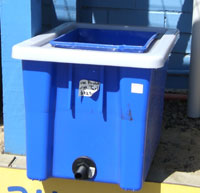
Generally speaking, laundry water is quite alkaline due to the detergents used, and this can, with application over prolonged periods, alter the pH of the soil, making conditions unpleasant for loads of plants and for soil microbes (more on that later). Plant preferences for certain types of soil means that they are often starved of important nutrients or damaged by unwanted minerals when the pH is altered.
The make up of laundry liquids and powders is complex, and relies on a myriad of different chemicals and compounds to do its work. Laundry detergents need to be alkaline in order to “attract” grease, fats and all those yucky things that make us need to wash our clothes in the first place.
Laundry detergents also contain “surfactants”, substances which, when added to water, significantly reduce the surface tension of the water, allowing water to wash surfaces better. There are many different types of organic compounds which can function as surfactants, but, while they might get our clothes cleaner, they aren’t doing our soil, or the critters living in the soil, much good.
So, in basic terms, much laundry water has the potential to cause significant changes to soil structure, soil pH, and, in turn, affect how our plants grow. Using detergents with a neutral pH (or close to it) will help keep soil pH at a desirable level. If you are finding your greywater to be alkaline, adding white vinegar (which is slightly acid) to the greywater before applying it to the soil may be beneficial for the long-term health of plants and soil. The amount of vinegar required will vary depending on the starting greywater pH, test it out for yourself!
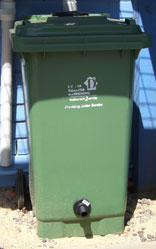
Loads of native and exotic plant species do not tolerate an alkaline soil (most of our native soils in Australia are quite acidic, SA being the exception) so monitoring of the soil pH over time is important. The magic word here is ‘test’ i.e. test your pH for yourself, and see where you stand.
pH testing kits are available from most garden centres, aquariam retailers and pet supply stores, and are specifically designed to test the pH, acidity and alkalinity of water (including greywater). Soil pH testing kits are also available, and are an essential addition to the garden shed!
I heard greywater is salty – is it?
Salinity is mainly a problem with washing machine water as many powder detergents have a high salt content due to the use of fillers in laundry powders. Preferably do not use saline greywater, especially with clay soil types, unless your plants can tolerate it. You could add gypsum to the wash water if it is saline (i.e. high sodium concentration). Alternatively, using liquid detergents or choosing powders with no sodium content are much safer and environmentally responsible options.
What do I do with all this water?
The biggest issue faced by gardeners irrigating with untreated greywater is not necessarily the quality of the water, but the amount of it and frequency at which it is being applied. Put simply, people are watering more than they ever did and are literally drowning their plants and their soil. Please, for the love of the Garden Gods, check your soil moisture before irrigating. If the soil is damp, direct your greywater to the sewer, rather than to the garden! Greywater cannot be stored for longer than 24hours, so, if you don’t need it, divert it! Oh, and give your soil time to recover. All soils under greywater irrigation should be allowed freshwater and the best time for this is through winter, when rainwater is generally available. So turn off your greywater over autumn and winter, and flick it back on as the weather warms up and the rains stop!

What about the water from my bathroom?
On average, a two to three person household generates 185 litres of greywater per day from the hand basin, shower and bath. The chemical constituents of bathroom greywater include soap, shampoo, hair dyes, toothpaste and cleaning chemicals. Greywater from hand basins is more polluted than bath or shower greywater, but is much lower in volume. If hair dyes and cleaning chemicals are being utilised, divert the greywater to the wastewater rather than the garden.
I get asked quite often how the use of soaps and shampoos will impact the quality of greywater used for garden irrigation, and the short answer is “we don’t know”. Generally speaking, the amount of soap and shampoo used in the shower is quite minimal, and pretty well diluted by the time it gets out to the garden. Most of it is biodegradable, and is unlikely to have any significant long-term impact on the plants and soil. That said, the impacts of all types of greywater are dependant on a whole host of factors, including soil types, organic matter content and so on.
What will greywater do to my soil?
Hard to say really! As we have learnt, the use of greywater with a high content of laundry detergent can be quite harmful to plants, causing phosphorus toxicity and sodium issues. But the truth is, we don’t know at this stage what the long-term impact of greywater use on gardens will be. The widespread use of greywater for irrigation is a fairly new beast, and one that, until now, has not been studied a great deal. While there are numerous studies underway, the outcome on soil health will not be known for some time. But we can infer a few things at this stage:

· Harsh chemicals that are designed to kill household bugs are most likely to kill beneficial bugs in the soil. This includes the use of eucalyptus oil, nappy soakers, antiseptic and anti-bacterial products and carbolic acid based disinfectants.
· Petroleum based products such as some detergents and optical brighteners – they are slow to bio-degrade and probably not real good for the soil
Maintaining soil health by adding plenty of organic matter is essential (even more than usual) to counteract the effects of any additional salt. It will also help to buffer the pH because another benefit of adding lots of organic matter is that it can help lower pH, which in turns makes less phosphorous available to plants. Check out the Soil Health section at the top of our website for more information on the importance of healthy soils!
Greywater is great… an awesome resource that, when used correctly and cleverly, can prevent our precious potable drinking water from being dumped into garden beds.
Related Articles:
Thriving in the Heat: Managing Plant Heat Stress
As the mercury rises, your garden confronts the challenge of heat stress. Understanding how various plants respond to heat and employing appropriate…
Water Smart Gardening 101 Video
Sustainable Gardening 101 Video Series PART 4: Water Smart Gardening As the climate changes we need to take extra care to design water smart gardens.…

